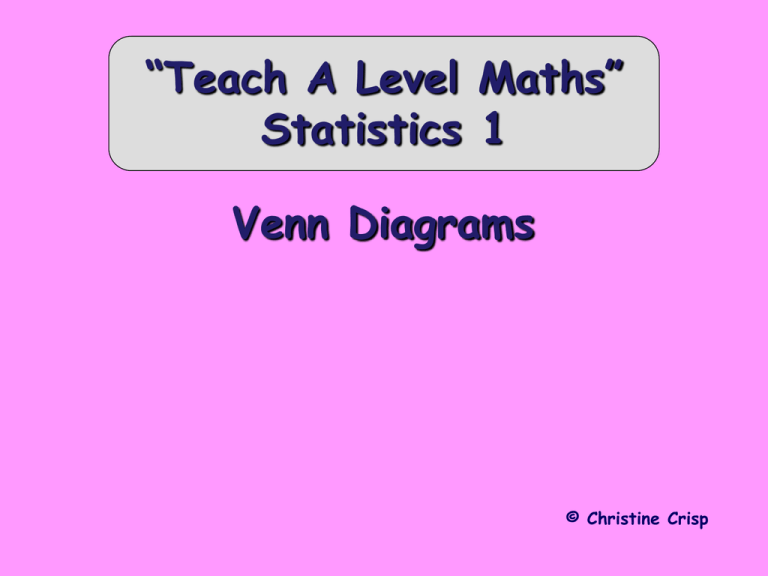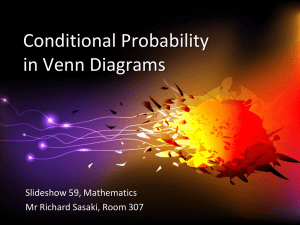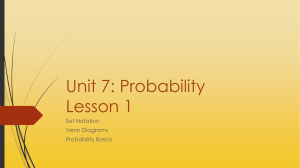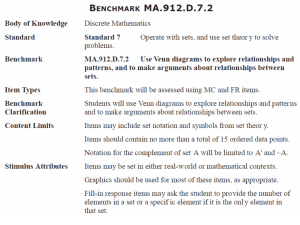11 Venn Diagrams
advertisement

“Teach A Level Maths” Statistics 1 Venn Diagrams © Christine Crisp Venn Diagrams Statistics 1 AQA EDEXCEL MEI/OCR OCR "Certain images and/or photos on this presentation are the copyrighted property of JupiterImages and are being used with permission under license. These images and/or photos may not be copied or downloaded without permission from JupiterImages" Venn Diagrams Venn diagrams show the probabilities of more than one event and can be used instead of tree diagrams. They are quick and easy to use. Those of you taking the Edexcel or MEI specifications need to understand these diagrams. For the rest of you their use is optional but I am going to use them to illustrate some important laws of probability. Venn Diagrams e.g.1 Amongst a group of 20 students, 7 are taking Maths and of these 3 are also taking Biology. 5 are taking neither. What is the probability that a student chosen at random is taking Biology? Solution: The diagram shows the 20 students. 20 The “eggs” show Maths and Biology 3 do both 5 do neither B M 4 3 5 7 do Maths ( but we have 3 already ) Venn Diagrams e.g.1 Amongst a group of 20 students, 7 are taking Maths and of these 3 are also taking Biology. 5 are taking neither. What is the probability that a student chosen at random is taking Biology? Solution: The diagram shows the 20 students. 20 The final number ( doing Biology but not Maths ) is given by B M 4 3 8 20 4 3 5 8 So, P( student takes Biology ) = 5 3 8 20 11 20 Venn Diagrams e.g.2 In a class of 30 students, 3 out of the 16 girls and 6 out of the 14 boys, are left-handed. Draw a Venn diagram and find the probability that a student chosen at random is a boy or left-handed. Solution: The diagram needs to show the numbers for Left-handedness and Boys. 30 B L There are 6 Lefthanded Boys . . . so there are 8 boys who are not. There are 3 lefthanded girls . . . and 13 who are right-handed. 3 6 8 13 Venn Diagrams e.g.2 In a class of 30 students, 3 out of the 16 girls and 6 out of the 14 boys, are left-handed. Draw a Venn diagram and find the probability that a student chosen at random is a boy or left-handed. Solution: The diagram needs to show the numbers for Left-handedness and Boys. 30 B L 3 6 8 13 P( boy or a left-hander ) = 3 6 8 30 17 30 Venn Diagrams Exercise 1. Customers at a restaurant are offered a choice of chips or jacket potato to go with either lasagna or pizza. Out of a group of 16, 11 have the lasagna. 7 choose chips to accompany their meal. 5 of those who choose chips have the lasagna. What is the probability that one chosen at random has neither chips nor lasagna? Solution: L: lasagna C: chips L C Venn Diagrams Exercise 1. Customers at a restaurant are offered a choice of chips or jacket potato to go with either lasagna or pizza. Out of a group of 16, 11 have the lasagna. 7 choose chips to accompany their meal. 5 of those who choose chips have the lasagna. What is the probability that one chosen at random has neither chips nor lasagna? Solution: L: lasagna C: chips 16 L C Venn Diagrams Exercise 1. Customers at a restaurant are offered a choice of chips or jacket potato to go with either lasagna or pizza. Out of a group of 16, 11 have the lasagna. 7 choose chips to accompany their meal. 5 of those who choose chips have the lasagna. What is the probability that one chosen at random has neither chips nor lasagna? Solution: L: lasagna C: chips 16 C L 5 Venn Diagrams Exercise 1. Customers at a restaurant are offered a choice of chips or jacket potato to go with either lasagna or pizza. Out of a group of 16, 11 have the lasagna. 7 choose chips to accompany their meal. 5 of those who choose chips have the lasagna. What is the probability that one chosen at random has neither chips nor lasagna? Solution: L: lasagna C: chips 16 C L 6 5 Venn Diagrams Exercise 1. Customers at a restaurant are offered a choice of chips or jacket potato to go with either lasagna or pizza. Out of a group of 16, 11 have the lasagna. 7 choose chips to accompany their meal. 5 of those who choose chips have the lasagna. What is the probability that one chosen at random has neither chips nor lasagna? Solution: L: lasagna C: chips 16 C L 6 5 2 Venn Diagrams Exercise 1. Customers at a restaurant are offered a choice of chips or jacket potato to go with either lasagna or pizza. Out of a group of 16, 11 have the lasagna. 7 choose chips to accompany their meal. 5 of those who choose chips have the lasagna. What is the probability that one chosen at random has neither chips nor lasagna? Solution: L: lasagna C: chips 16 C L 6 5 2 3 Venn Diagrams Exercise 1. Customers at a restaurant are offered a choice of chips or jacket potato to go with either lasagna or pizza. Out of a group of 16, 11 have the lasagna. 7 choose chips to accompany their meal. 5 of those who choose chips have the lasagna. What is the probability that one chosen at random has neither chips nor lasagna? Solution: L: lasagna 16 C: chips C L 6 5 2 P(no chips, no lasagna) 3 16 3 Venn Diagrams We’ll use the example about left-handed students to illustrate a law of probability. 30 B L 3 6 8 13 I’ll change this to A as we usually use A when we state the law. Venn Diagrams We’ll use the example about left-handed students to illustrate a law of probability. 30 B A 3 6 8 13 Venn Diagrams We’ll use the example about left-handed students to illustrate a law of probability. 30 B A 3 6 8 13 The number in A or B is anything shaded. N.B. A or B in probability includes both. Venn Diagrams We’ll use the example about left-handed students to illustrate a law of probability. 30 B A n( A or B ) = 17 3 6 8 13 We’ll use n for “ the number in . . .”, so n( A or B ) = 3 + 6 + 8 = 17 Venn Diagrams We’ll use the example about left-handed students to illustrate a law of probability. 30 B A 3 6 n( A or B ) = 17 n(A) = 9 8 13 n(A) = 9 n(B) = Venn Diagrams We’ll use the example about left-handed students to illustrate a law of probability. 30 B A 3 6 n( A or B ) = 17 n(A) = 9 8 n(B) = 14 13 n(A) = 9 n(B) = 14 Venn Diagrams We’ll use the example about left-handed students to illustrate a law of probability. 30 B A 3 6 n( A or B ) = 17 n(A) = 9 8 n(B) = 14 13 n(A and B) = 6 The part with both types of shading gives the number in A and B. So, n( A and B ) = 6 Venn Diagrams We’ll use the example about left-handed students to illustrate a law of probability. 30 B A 6 3 n( A or B ) = 17 n(A) = 9 8 n(B) = 14 13 We now get n(A and B) = 6 n( A or B ) = n(A) n(B) n( A and B ) 17 = 9 14 6 N.B. The part with both types of shading is in A and in B so it has been counted twice. We subtract one lot. Venn Diagrams We’ll use the example about left-handed students to illustrate a law of probability. 30 B A 3 6 n( A or B ) = 17 n(A) = 9 8 n(B) = 14 13 We now get n(A and B) = 6 n( A or B ) = n(A) n(B) n( A and B ) Dividing by 30 gives probabilities, so P( A or B ) = P(A) + P(B) – P(A and B) Venn Diagrams If A and B don’t overlap, P(A and B) = 0 A B ( the intersection is empty ) So, P( A or B ) = P(A) + P(B) – P(A and B) P( A or B ) = P(A) + P(B) A and B are said to be mutually exclusive events. ( If A happens, B cannot or if B happens, A cannot. ) Venn Diagrams Notation We can write P(A or B) as P(A B) I remember the notation by thinking of this symbol as a cup which can hold anything in A or B. and so, P(A and B) as P(A B) P( A or B ) = P(A) + P(B) – P(A and B) becomes P( A B ) = P(A) + P(B) – P(A B) Also, P( A/ ) means “ the probability that event A does not occur ” Venn Diagrams SUMMARY If A and B are 2 events P(A or B) can be written as P(A B) P(A and B) can be written as P(A B) P( A or B ) = P(A) + P(B) – P(A and B) If P(A and B ) = 0, A and B are mutually exclusive and then, P( A or B ) = P(A) + P(B) Venn Diagrams e.g.1 Events A and B are such that and P(A or B) Solution: 17 , 25 P(B) Find P(A and B). . 5 P(A or B) = P(A) + P(B) – P(A and B) 4 4 P(A) 17 5 25 P(A and B) 17 25 2 5 2 5 4 5 17 10 20 25 7 25 P(A and B) 2 5 Venn Diagrams e.g.2 In a group of 15 mixed plants, 6 are petunias, 8 are yellow and 3 are both. What is the probability if a plant is picked at random that it is (a) either a petunia or yellow (b) either a petunia or yellow but not both? Solution: Let P be event ”Petunia” and Y be event “Yellow” (a) We want to find P(P or Y) P( P or Y ) = P(P) + P(Y) – P(P and Y) Venn Diagrams e.g.2 In a group of 15 mixed plants, 6 are petunias, 8 are yellow and 3 are both. What is the probability if a plant is picked at random that it is (a) either a petunia or yellow (b) either a petunia or yellow but not both? Solution: Let P be event ”Petunia” and Y be event “Yellow” (a) We want to find P(P or Y) P( P or Y ) = P(P) + P(Y) – P(P and Y) 6 15 Venn Diagrams e.g.2 In a group of 15 mixed plants, 6 are petunias, 8 are yellow and 3 are both. What is the probability if a plant is picked at random that it is (a) either a petunia or yellow (b) either a petunia or yellow but not both? Solution: Let P be event ”Petunia” and Y be event “Yellow” (a) We want to find P(P or Y) P( P or Y ) = P(P) + P(Y) – P(P and Y) 6 15 8 15 Venn Diagrams e.g.2 In a group of 15 mixed plants, 6 are petunias, 8 are yellow and 3 are both. What is the probability if a plant is picked at random that it is (a) either a petunia or yellow (b) either a petunia or yellow but not both? Solution: Let P be event ”Petunia” and Y be event “Yellow” (a) We want to find P(P or Y) P( P or Y ) = P(P) + P(Y) – P(P and Y) 6 15 8 3 15 15 Venn Diagrams e.g.2 In a group of 15 mixed plants, 6 are petunias, 8 are yellow and 3 are both. What is the probability if a plant is picked at random that it is (a) either a petunia or yellow (b) either a petunia or yellow but not both? Solution: Let P be event ”Petunia” and Y be event “Yellow” (a) We want to find P(P or Y) P( P or Y ) = P(P) + P(Y) – P(P and Y) 6 15 11 8 3 15 15 15 (b) We must subtract another P(P and Y). ANS: 8 15 A Venn diagram can also be used to answer the question. Venn Diagrams e.g.2 In a group of 15 mixed plants, 6 are petunias, 8 are yellow and 3 are both. What is the probability if a plant is picked at random that it is (a) either a petunia or yellow (b) either a petunia or yellow but not both? Solution: Let P be event ”Petunia” and Y be event “Yellow” (a) We want to find P(P or Y) P Y Venn Diagrams e.g.2 In a group of 15 mixed plants, 6 are petunias, 8 are yellow and 3 are both. What is the probability if a plant is picked at random that it is (a) either a petunia or yellow (b) either a petunia or yellow but not both? Solution: Let P be event ”Petunia” and Y be event “Yellow” (a) We want to find P(P or Y) 15 P Y Venn Diagrams e.g.2 In a group of 15 mixed plants, 6 are petunias, 8 are yellow and 3 are both. What is the probability if a plant is picked at random that it is (a) either a petunia or yellow (b) either a petunia or yellow but not both? Solution: Let P be event ”Petunia” and Y be event “Yellow” (a) We want to find P(P or Y) 15 Y P 3 Venn Diagrams e.g.2 In a group of 15 mixed plants, 6 are petunias, 8 are yellow and 3 are both. What is the probability if a plant is picked at random that it is (a) either a petunia or yellow (b) either a petunia or yellow but not both? Solution: Let P be event ”Petunia” and Y be event “Yellow” (a) We want to find P(P or Y) 15 Y P 3 3 Venn Diagrams e.g.2 In a group of 15 mixed plants, 6 are petunias, 8 are yellow and 3 are both. What is the probability if a plant is picked at random that it is (a) either a petunia or yellow (b) either a petunia or yellow but not both? Solution: Let P be event ”Petunia” and Y be event “Yellow” (a) We want to find P(P or Y) 15 Y P 3 3 5 Venn Diagrams e.g.2 In a group of 15 mixed plants, 6 are petunias, 8 are yellow and 3 are both. What is the probability if a plant is picked at random that it is (a) either a petunia or yellow (b) either a petunia or yellow but not both? Solution: Let P be event ”Petunia” and Y be event “Yellow” (a) We want to find P(P or Y) 15 Y P 3 3 P(P or Y) = 5 4 Venn Diagrams e.g.2 In a group of 15 mixed plants, 6 are petunias, 8 are yellow and 3 are both. What is the probability if a plant is picked at random that it is (a) either a petunia or yellow (b) either a petunia or yellow but not both? Solution: Let P be event ”Petunia” and Y be event “Yellow” (a) We want to find P(P or Y) 15 Y P 3 3 P(P or Y) = 5 4 (b) 11 15 Venn Diagrams e.g.2 In a group of 15 mixed plants, 6 are petunias, 8 are yellow and 3 are both. What is the probability if a plant is picked at random that it is (a) either a petunia or yellow (b) either a petunia or yellow but not both? Solution: Let P be event ”Petunia” and Y be event “Yellow” (a) We want to find P(P or Y) 15 Y P 3 3 P(P or Y) = 5 4 (b) 8 15 11 15 Venn Diagrams e.g.3 A, B are 2 events such that P ( A ) 0 5 , P ( B ) 0 7 and P ( A / B / ) 0 2 Draw a Venn diagram and use it to help you to find P ( A B ) Solution: Let P ( A B ) p P (A ) 0 5 , B A p Venn Diagrams e.g.3 A, B are 2 events such that P ( A ) 0 5 , P ( B ) 0 7 and P ( A / B / ) 0 2 Draw a Venn diagram and use it to help you to find P ( A B ) Solution: Let P ( A B ) p P (A ) 0 5 , and P ( B ) 0 7 . B A 05 p p Venn Diagrams e.g.3 A, B are 2 events such that P ( A ) 0 5 , P ( B ) 0 7 and P ( A / B / ) 0 2 Draw a Venn diagram and use it to help you to find P ( A B ) Solution: Let P ( A B ) p P (A ) 0 5 , and P ( B ) 0 7 . B A 05 p p 07 p Venn Diagrams e.g.3 A, B are 2 events such that P ( A ) 0 5 , P ( B ) 0 7 and P ( A / B / ) 0 2 Draw a Venn diagram and use it to help you to find P ( A B ) Solution: Let P ( A B ) p P (A ) 0 5 , and P ( B ) 0 7 . Finally, P (A / B A 05 p p 07 p 02 / B ) 02 ( probability of not in A and not in B ) The total probability is 1, so 05 p p 07 p 021 14 p 1 p 04 Venn Diagrams Exercise 1. 1 , Events A and B are such that P(B) 2 1 and P(A and B) . Find P(A). 8 P(A or B) 5 8 2. In a group of 20 students, 8 play music, 11 belong to a sports team and 6 do both. What is the probability that a student picked at random from the group plays music or belongs to a sports team? Venn Diagrams Solutions: 5 1. Events A and B are such that P(B) 1 , P(A or B) and P(A and B) Either: 1 8 . Find P(A). 8 2 P(A or B) = P(A) + P(B) – P(A and B) 5 8 P(A) = P(A) + 1 2 1 8 1 4 Or: A B Venn Diagrams Solutions: 5 1. Events A and B are such that P(B) 1 , P(A or B) and P(A and B) Either: 1 8 . Find P(A). 8 2 P(A or B) = P(A) + P(B) – P(A and B) 5 8 P(A) = P(A) + 1 2 1 8 1 4 Or: B A 1 8 Venn Diagrams Solutions: 5 1. Events A and B are such that P(B) 1 , P(A or B) and P(A and B) Either: 1 8 . Find P(A). 8 2 P(A or B) = P(A) + P(B) – P(A and B) 5 8 P(A) = P(A) + 1 2 1 8 1 4 Or: B A 1 3 8 8 Venn Diagrams Solutions: 5 1. Events A and B are such that P(B) 1 , P(A or B) and P(A and B) Either: 1 8 . Find P(A). 8 2 P(A or B) = P(A) + P(B) – P(A and B) 5 8 P(A) = P(A) + 1 1 8 2 1 4 Or: B A 1 1 3 8 8 8 Venn Diagrams Solutions: 5 1. Events A and B are such that P(B) 1 , P(A or B) and P(A and B) Either: 1 8 . Find P(A). 8 2 P(A or B) = P(A) + P(B) – P(A and B) 5 8 P(A) = P(A) + 1 1 8 2 1 4 Or: P(A) = 1 4 B A 1 1 3 8 8 8 Venn Diagrams Exercise 2. In a group of 20 students, 8 play music, 11 belong to a sports team and 6 do both. What is the probability that a student picked at random from the group plays music or belongs to a sports team? Solution: Let M be event “plays music” and S “is in sports team” Either: P(M or S) = P(M) + P(S) – P(M and S) 8 20 13 20 11 20 6 20 Venn Diagrams Exercise 2. In a group of 20 students, 8 play music, 11 belong to a sports team and 6 do both. What is the probability that a student picked at random from the group plays music or belongs to a sports team? Solution: Let M be event “plays music” and S “is in sports team” Or: 20 S M 2 6 P(M or S) 5 7 13 20 The following slides contain repeats of information on earlier slides, shown without colour, so that they can be printed and photocopied. For most purposes the slides can be printed as “Handouts” with up to 6 slides per sheet. Venn Diagrams Venn Diagrams Venn diagrams show the probabilities of more than one event and can be used instead of tree diagrams. They are quick and easy to use. Those of you taking the Edexcel or MEI specifications need to understand these diagrams. For the rest of you their use is optional but I am going to use them to illustrate some important laws of probability. Venn Diagrams e.g.1 Amongst a group of 20 students, 7 are taking Maths and of these 3 are also taking Biology. 5 are taking neither. What is the probability that a student chosen at random is taking Biology? Solution: The diagram shows the 20 students. 20 The “eggs” show Maths and Biology B M 4 3 8 The number doing Biology but not Maths is given by 5 20 4 3 5 8 So, P( student takes Biology ) = 11 20 Venn Diagrams e.g.2 In a class of 30 students, 3 out of the 16 girls and 6 out of the 14 boys, are left-handed. Draw a Venn diagram and find the probability that a student chosen at random is a boy or left-handed. Solution: The diagram needs to show the numbers for Left-handedness and Boys. There are 6 lefthanded boys so 8 boys are not. 30 B L There are 3 lefthanded girls and 13 right-handed P( boy or a left-hander ) = 3 6 8 13 3 6 8 30 17 30 Venn Diagrams We’ll use the example about left-handed students to illustrate a law of probability. 30 B A 3 6 n( A or B ) = 17 n(A) = 9 8 n(B) = 14 13 We now get n(A and B) = 6 n( A or B ) = n(A) n(B) n( A and B ) Dividing by 30 gives probabilities, so P( A or B ) = P(A) + P(B) – P(A and B) Venn Diagrams SUMMARY If A and B are 2 events P(A or B) can be written as P(A B) P(A and B) can be written as P(A B) P( A or B ) = P(A) + P(B) – P(A and B) If P(A and B ) = 0, A and B are mutually exclusive and then, P( A or B ) = P(A) + P(B)





